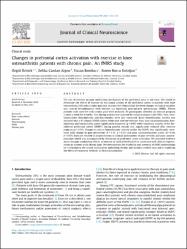| dc.contributor.author | Öztürk, Özgül | |
| dc.contributor.author | Algun, Zeliha Candan | |
| dc.contributor.author | Bombacı, Hasan | |
| dc.contributor.author | Erdoğan, Sinem Burcu | |
| dc.date.accessioned | 2021-06-25T06:04:23Z | |
| dc.date.available | 2021-06-25T06:04:23Z | |
| dc.date.issued | 2021 | en_US |
| dc.identifier.citation | Öztürk, Ö., Algun, Z. C., Bombacı, H. ve Erdoğan, S. B. (2021). Changes in prefrontal cortex activation with exercise in knee osteoarthritis patients with chronic pain: An fNIRS study. Journal of Clinical Neuroscience, 90, 144-151. https://dx.doi.org/10.1016/j.jocn.2021.05.055 | en_US |
| dc.identifier.issn | 0967-5868 | |
| dc.identifier.uri | https://dx.doi.org/10.1016/j.jocn.2021.05.055 | |
| dc.identifier.uri | https://hdl.handle.net/20.500.12511/7311 | |
| dc.description.abstract | The role of exercise on pain modulatory mechanism of the prefrontal areas is not clear. We aimed to determine the effects of exercise on functional activity of the prefrontal cortex in patients with knee osteoarthritis (OA) with chronic pain and to assess the relationships between changes in clinical variables and cortical hemodynamics with exercise via functional near-infrared spectroscopy (fNIRS). Fifteen patients with knee OA with chronic pain were included. All participants attended an exercise program 3 times a week for 6 weeks. Pain during activity was assessed by visual analogue scale (VAS). Pain catastrophization, kinesiophobia and functionality were also measured. Brain hemodynamic activity was assessed with a 47-channel fNIRS system before and after the exercise. Pain, pain catastrophization, kinesiophobia and functionality scores significantly improved (p < 0.05) while functional activity of the dorsolateral prefrontal cortex (DLPFC) during painful stimuli was significantly reduced after exercise program (p < 0.05). Change in cortical hemodynamic activity within the DLPFC was significantly correlated with change in pain perception (R = 0.54, p < 0.05) and pain catastrophization scores (R = 0.44, p < 0.05). Exercise resulted in improvements in clinical assessments of pain severity and pain catastrophization which was accompanied by alterations in prefrontal cortex activation. We provided evidence about the pain modulatory effects of exercise at cortical level which is correlated with clinical improvements in patients with chronic pain. We demonstrate the feasibility and potential of fNIRS methodology for i) elucidating the neural mechanisms underlying chronic and stimulus evoked pain, and ii) exploring the effect of treatment methods on brain functionality. | en_US |
| dc.language.iso | eng | en_US |
| dc.publisher | Churchill Livingstone | en_US |
| dc.rights | info:eu-repo/semantics/embargoedAccess | en_US |
| dc.subject | Chronic Pain | en_US |
| dc.subject | Exercise | en_US |
| dc.subject | fNIRS | en_US |
| dc.subject | Knee Osteoarthritis | en_US |
| dc.subject | Neuroimaging | en_US |
| dc.title | Changes in prefrontal cortex activation with exercise in knee osteoarthritis patients with chronic pain: An fNIRS study | en_US |
| dc.type | article | en_US |
| dc.relation.ispartof | Journal of Clinical Neuroscience | en_US |
| dc.department | İstanbul Medipol Üniversitesi, Sağlık Bilimleri Fakültesi, Fizyoterapi ve Rehabilitasyon Bölümü | en_US |
| dc.authorid | 0000-0002-2476-6567 | en_US |
| dc.identifier.volume | 90 | en_US |
| dc.identifier.startpage | 144 | en_US |
| dc.identifier.endpage | 151 | en_US |
| dc.relation.tubitak | info:eu-repo/grantAgreement/TUBITAK/SOBAG/118S750 | en_US |
| dc.relation.publicationcategory | Makale - Uluslararası Hakemli Dergi - Kurum Öğretim Elemanı | en_US |
| dc.identifier.doi | 10.1016/j.jocn.2021.05.055 | en_US |
| dc.identifier.wosquality | Q4 | en_US |
| dc.identifier.scopusquality | Q2 | en_US |


















